Atacama Cosmology Telescope (ACT)
Links: ACT website, Laura Newburgh
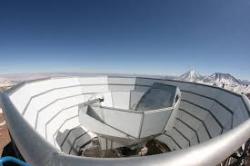 ACT is a 6m radio telescope dish located in the Atacama Desert in Northern Chile. The Yale team uses the telescope to make high resolution measurements of the Cosmic Microwave Background (CMB), which is the relic light from the Universe when it was ~380,000 years old. Measurements of the CMB have been a workhorse in precision cosmology, constraining parameters like the geometry of the Universe and its constituents (dark matter, baryonic matter, neutrinos, dark energy) and provide the high-precision measurements required for additional constraints from Large Scale Structure.
ACT is a 6m radio telescope dish located in the Atacama Desert in Northern Chile. The Yale team uses the telescope to make high resolution measurements of the Cosmic Microwave Background (CMB), which is the relic light from the Universe when it was ~380,000 years old. Measurements of the CMB have been a workhorse in precision cosmology, constraining parameters like the geometry of the Universe and its constituents (dark matter, baryonic matter, neutrinos, dark energy) and provide the high-precision measurements required for additional constraints from Large Scale Structure.
Argon Neutrino Test (ArgoNeuT)
Links: Fermilab website, Yale website, Bonnie Fleming
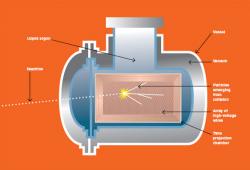 ArgoNeuT, an R&D experiment designed to detect and record neutrino interactions from the Neutrinos at the Main Injector (NuMI) beam at Fermi National Accelerator Laboratory (Fermilab), was the first Liquid Argon Time Projection Chamber (LArTPC) operating in a low energy neutrino and antineutrino beam, the region of interest for current short-baseline and future long-baseline experiments. In addition to demonstrating technology for larger detectors and contributing to the development of reconstruction algorithms that will be useful in future experiments, ArgoNeuT has provided a wealth of physics results on neutrino interaction mechanisms, and is still yielding new intriguing outputs from the on-going studies. The Yale team played a leading role in the project and the group is currently analyzing and using the data for several research programs.
ArgoNeuT, an R&D experiment designed to detect and record neutrino interactions from the Neutrinos at the Main Injector (NuMI) beam at Fermi National Accelerator Laboratory (Fermilab), was the first Liquid Argon Time Projection Chamber (LArTPC) operating in a low energy neutrino and antineutrino beam, the region of interest for current short-baseline and future long-baseline experiments. In addition to demonstrating technology for larger detectors and contributing to the development of reconstruction algorithms that will be useful in future experiments, ArgoNeuT has provided a wealth of physics results on neutrino interaction mechanisms, and is still yielding new intriguing outputs from the on-going studies. The Yale team played a leading role in the project and the group is currently analyzing and using the data for several research programs.
DM-Ice
Links: DM-Ice website, Reina Maruyama
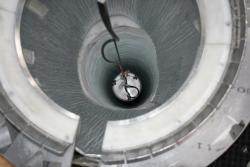 DM-Ice is a direct-detection dark matter experiment to test DAMA’s assertion that the observed annual modulation is due to dark matter. DM-Ice aims to understand the origin of DAMA’s signal by using the same target, and is the only experiment with access to both Northern and Southern Hemispheres. DM-Ice is a phased experimental program; the current phase is COSINE-100.
DM-Ice is a direct-detection dark matter experiment to test DAMA’s assertion that the observed annual modulation is due to dark matter. DM-Ice aims to understand the origin of DAMA’s signal by using the same target, and is the only experiment with access to both Northern and Southern Hemispheres. DM-Ice is a phased experimental program; the current phase is COSINE-100.
The Enriched Xenon Observatory (EXO-200)
Links: EXO-200 website, David Moore
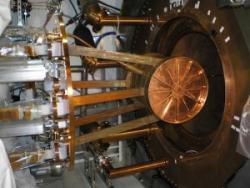 EXO-200 is a detector which contains ~150 kg of liquid 136Xe in a radiopure time projection chamber (TPC) installed underground at the Waste Isolation Pilot Plant (WIPP) in Carlsbad, NM. EXO-200 is searching for the extremely rare neutrinoless double beta decay of 136Xe, which can only occur if neutrinos are Majorana particles — i.e. if there is no fundamental difference between a neutrino and antineutrino. Observing neutrinoless double beta decay would provide direct evidence for new physics beyond the Standard Model of particle physics. It would also have implications for theories attempting to describe the nature of neutrinos, how neutrinos acquire their masses, and how the small excess of matter over antimatter was generated in the early universe.
EXO-200 is a detector which contains ~150 kg of liquid 136Xe in a radiopure time projection chamber (TPC) installed underground at the Waste Isolation Pilot Plant (WIPP) in Carlsbad, NM. EXO-200 is searching for the extremely rare neutrinoless double beta decay of 136Xe, which can only occur if neutrinos are Majorana particles — i.e. if there is no fundamental difference between a neutrino and antineutrino. Observing neutrinoless double beta decay would provide direct evidence for new physics beyond the Standard Model of particle physics. It would also have implications for theories attempting to describe the nature of neutrinos, how neutrinos acquire their masses, and how the small excess of matter over antimatter was generated in the early universe.
Liquid Argon TPC in a Testbeam (LArIAT)
Links: Fermilab website, Yale website, Bonnie Fleming
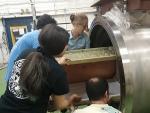 LArIAT is a project at Fermilab to calibrate the Liquid Argon Time Projection Chamber (LArTPC) technology. LArIAT uses the repurposed ArgoNeuT TPC in the Fermilab Test Beam Facility (FTBF).
LArIAT is a project at Fermilab to calibrate the Liquid Argon Time Projection Chamber (LArTPC) technology. LArIAT uses the repurposed ArgoNeuT TPC in the Fermilab Test Beam Facility (FTBF).
Micro Booster Neutrino Experiment (MicroBooNE)
Links: Fermilab website, Yale website, Bonnie Fleming
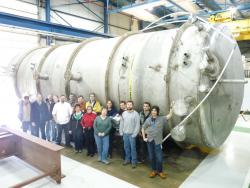
Persistent Current
Links: Harris Lab website, Jack Harris
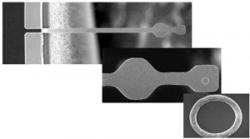 The Harris lab uses ultrasensitive micromechanical detectors to study mesoscopic electronic systems. This work focuses on normal-metal persistent currents, a quantum phenomenon in which electrical current flows through a resistor in the absence of a voltage.
The Harris lab uses ultrasensitive micromechanical detectors to study mesoscopic electronic systems. This work focuses on normal-metal persistent currents, a quantum phenomenon in which electrical current flows through a resistor in the absence of a voltage.
Microcantilevers as probes of closed mesoscopic systems
Fabricating a sub-micron circuit on the end of a cantilever allows us to study it in isolation.
In-situ electron thermometry
Monitoring the devices superconducting transition makes it possible to determine the temperature of the isolated metal ring.
Persistent currents in normal-metal rings
A number of important questions remain unanswered about the properties of dissipationless currents flowing through resistors.
Short Baseline Near Detector (SBND)
Links: Fermilab website, Yale website, Bonnie Fleming
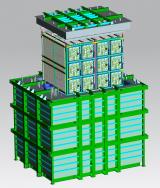 The SBND is a near detector experiment being developed on the Booster Neutrino Beamline at Fermilab upstream from MicroBooNE. While MicroBooNE will determine whether or not the low energy excess observed by MiniBooNE is electrons or photons, SBND will look for this excess at a near location to look for a baseline dependence of what MicroBooNE observes. The Yale team co-founded the experiment and is involved in the design of the SNBD detector and sensitivity studies. The Yale team is also constructing components of the TPC at Wright Lab, including the TPC field shaping system, the high voltage feedthrough and part of the scintillation light collection system.
The SBND is a near detector experiment being developed on the Booster Neutrino Beamline at Fermilab upstream from MicroBooNE. While MicroBooNE will determine whether or not the low energy excess observed by MiniBooNE is electrons or photons, SBND will look for this excess at a near location to look for a baseline dependence of what MicroBooNE observes. The Yale team co-founded the experiment and is involved in the design of the SNBD detector and sensitivity studies. The Yale team is also constructing components of the TPC at Wright Lab, including the TPC field shaping system, the high voltage feedthrough and part of the scintillation light collection system.

